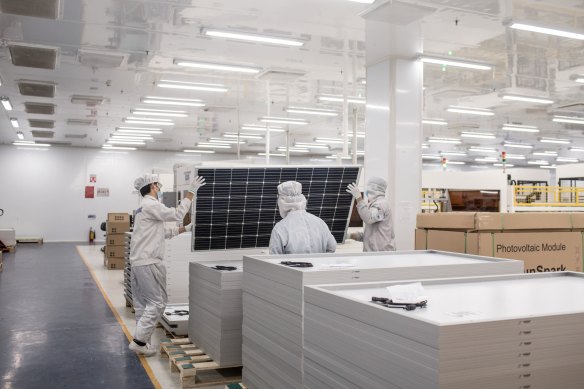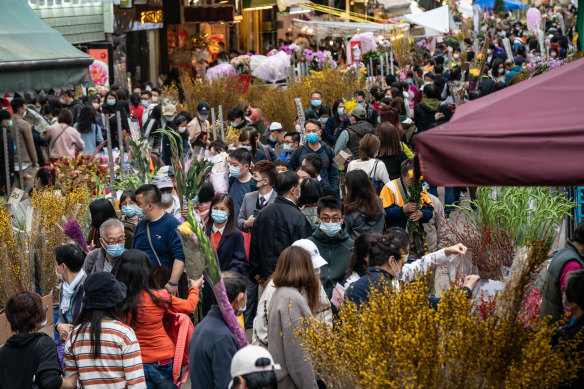
Beijing’s spare-no-expense policies are in particular focus as China doubles down on factory exports to compensate for a slowing domestic economy — drawing criticism from the United States, the European Union and other trading partners who contend that China’s heavy support of its industries is unfair.

China is the world leader in manufacturing solar panels, but its domestic industry is struggling. Credit: Bloomberg
China’s Communist Party leadership called Sunday for further investment in high-tech industries, including solar power. In his speech last week at the Republican National Convention, former President Donald Trump called for an end to the Biden administration’s renewable energy programs, which he labelled a “green new scam.”
The case study
The rise and fall of Hunan Sunzone Optoelectronics in Changsha, the capital of Hunan province in south-central China, is a case study of how China’s policies work.
Started in 2008, the solar panel manufacturer benefited early on from practically every possible subsidy. It got 22 acres of prime downtown land in the heart of the city almost for free. One of China’s biggest state-owned banks arranged a loan at a low interest rate. The Hunan provincial government then agreed to pay most of the interest.
Despite the financial help, Sunzone’s factory now sits empty. A large “Sunzone” sign on the second floor rusts in the swampy heat of Changsha. The only person still working at the site on a recent afternoon, a security guard, said that manufacturing equipment was removed in January and the factory was set to be demolished and turned into office buildings.
Loading
Sunzone epitomises how lavish lending from state-owned banks and generous local subsidies have produced manufacturing overcapacity. Solar companies cut costs and prices sharply to maintain market share. That led to a few low-cost survivors while many other competitors were driven out of business in China and around the world.
China’s banks, acting at Beijing’s direction, have lent so much money to the sector for factory construction that the country’s solar factory capacity is roughly double the entire world’s demand.
Sunzone’s 360-employee factory was big when it was built. Within a few years, rivals elsewhere in China were building much larger factories.
Sunzone’s rivals, including Tongwei and Longi Green Energy Technology, gained formidable economies from large-scale production. They have plowed part of their extra revenue into developing solar panels that are increasingly efficient at converting sunlight into electricity.
Many other factories, like Sunzone’s, quickly become obsolete.
“Enterprises continue to put advanced production capacity into operation to maintain competitiveness” said Zhang Jianhua, director of China’s National Energy Administration, at a news conference last month. “At the same time, the outdated production capacity is still extensive and needs to be gradually phased out.”
Solar manufacturers across China have been laying off thousands of workers to cut costs — and those workers may be the lucky ones because they qualify for months of severance pay. Other big solar companies have resorted to tactics like giving year-long unpaid vacations or 30 per cent pay cuts for employees who keep their jobs.
Yet some companies say that they are furloughing workers only in preparation for even bigger production pushes in the future. “We’re saying, ‘Go back to your farm and help with the harvest, and come back in the autumn when the new equipment is ready,’” said Zhang Haimeng, group vice president of Longi.

Beijing’s spare-no-expense policies are in particular focus as China doubles down on factory exports to compensate for a slowing domestic economy.Credit: Getty Images
Compounding the problems facing China’s solar energy companies is the rapid disappearance of local subsidies. Local governments are running out of money as a housing crisis makes it hard for them to sell long-term leases on state land to real estate developers — previously their biggest source of cash.
“They don’t have the money to support anything,” said Ocean Yuan, CEO of Grape Solar, a large distributor of solar panels.
China’s leaders are becoming concerned. The Ministry of Industry and Information Technology issued a draft rule this month that solar companies can borrow only 70 per cent of the money to build or expand factories, not the previous 80 per cent. Still, the change was too small to reduce China’s overcapacity, according to Frank Haugwitz, a solar industry consultant.
The West is raising barriers to China’s solar panels. Europe has begun barring their use in government procurement projects unless Chinese companies disclose their subsidies, which they refuse to do.
Partly because of worries about Chinese subsidies, President Joe Biden last month allowed steep tariffs that had expired to go back into force on solar products imported from Southeast Asia that use lots of Chinese components. And the Department of Commerce has begun trade cases against imported solar panels that could lead to further tariffs.
Loading
China’s solar panel manufacturers are resilient. Some of the largest have restarted operations, often with the help of banks and local governments, after collapsing a decade ago.
Zhao Feng, the founder of Sunzone, said he hoped that his company might also recover. A Sunzone shareholder filed a lawsuit in a Hunan court in 2018 to force the company into insolvency following losses, but later withdrew it. Zhao, who is now in the United States, said that he wanted to refocus the company on artificial intelligence and electric cars, the latest favourites of Chinese industrial policy.
“When we want to develop,” he said, “we will ask banks and the government for support.”
This article originally appeared in The New York Times.
The Business Briefing newsletter delivers major stories, exclusive coverage and expert opinion. Sign up to get it every weekday morning.









 Add Category
Add Category